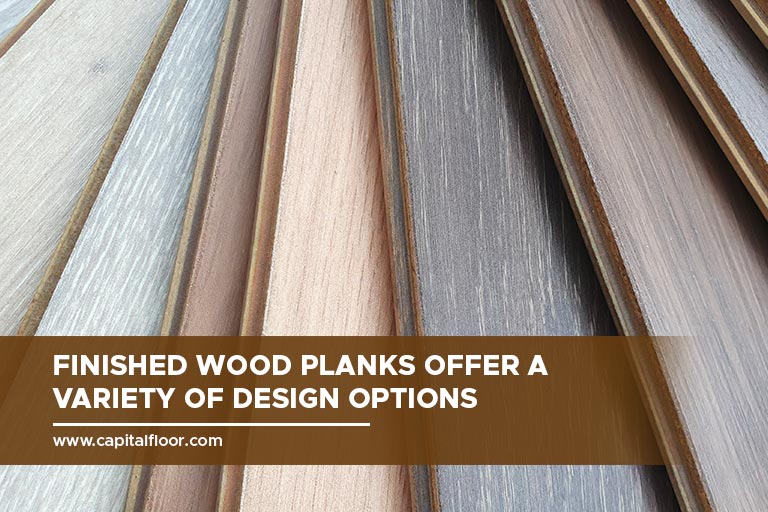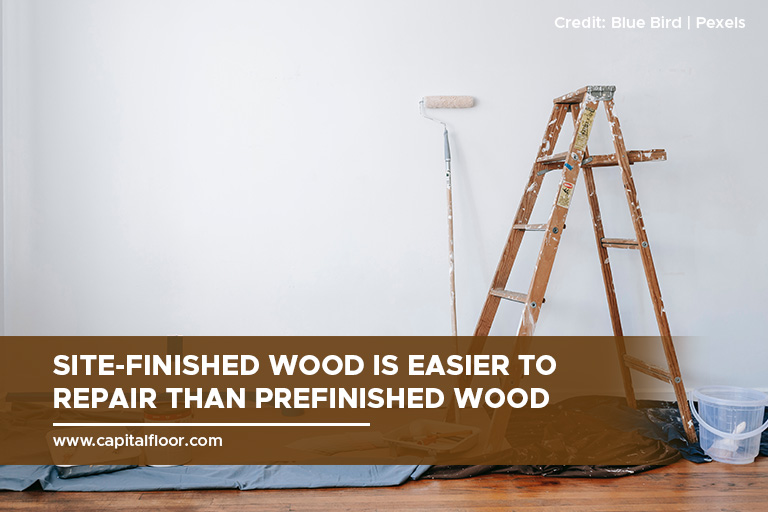Our showroom is open to the public. Please click HERE for more details.
Our showroom is open to the public. Please click HERE for more details.
When it comes to your new wood floor, one of the most important choices is deciding between site-finished vs prefinished hardwood flooring. Both options come with their own set of advantages and disadvantages, such as in style, pricing, installation, and maintenance. It is important to examine the distinctions thoroughly and pick the one that best aligns with your priorities before making a decision.
There is a great deal of uncertainty on the Internet about prefinished factory-finished hardwood flooring and solid unfinished hardwood flooring that is installed, sanded, and finished on-site. Learn more about each option and find the answer to the question, “What is the difference between site-finished and prefinished flooring?”
When you choose to opt for site-finished hardwood flooring, you’re buying unfinished wood to be delivered to your home. The flooring will then be sanded, possibly stained, and coated with a protective layer on-site at your home. This process takes time and can be messy due to the sanding, but dustless refinishing is available. One of the advantages of site-finished hardwood is that it allows for customization in various aspects of the installation, including:
Typically, on-site finishing is chosen if time is not a pressing issue and the construction project is new. This involves a lengthy process of sanding and cleaning the wooden flooring and applying the stain and multiple layers of topcoat. This can take anywhere from 3 to 5 days. You need to note that during this time, the floors cannot be walked on or used to hold furniture, and the odour from the finishing materials can be unpleasant.
Over the past 15 years, prefinished hardwood flooring has gained popularity due to advancements in hardwood manufacturing technology, providing more style, design, and performance choices. In the case of prefinished hardwood flooring, the finish is applied during manufacturing, and the product is delivered to your home ready for installation.
As a result, prefinished hardwood flooring has several advantages:
However, prefinished hardwood flooring problems exist as well. Prefinished hardwood flooring may have fewer options in terms of colour and finish, although borders and medallions can still be added for a customized result.
“Is pre-finished hardwood more durable, or is the site finished better?” is one of the many questions asked when deciding on hardwood flooring. You can choose from a wide range of prefinished and unfinished solid hardwood flooring, but it’s essential to figure out which type is most suitable for you.
Before making a final decision, you need to weigh the pros and cons of each option, considering factors like style, cost, ease of installation, and maintenance.

Prefinished hardwood flooring has gained almost a reputation and prestige similar to site-finished hardwood. Hardwood floors add more value to a property than similar products. Unfinished hardwood floors offer more options for customization, such as the type of wood, grain, finish, sheen level, and unique design elements. Still, as prefinished flooring becomes more popular, an increasing variety of options are available.
Factory-finished wood planks have slightly rounded edges, giving them a modern and manufactured look. However, finishing each board individually means the floor may not be entirely flat, resulting in visible lines or grooves between panels. Bevelled edges of prefinished flooring can trap dirt and grime, making cleaning more difficult, whereas site-finished floors have full, squared edges and a seamless finish.
Prefinished hardwood planks are generally priced higher than unfinished ones, but this price doesn’t cover labour costs for sanding, staining, and finishing. As a result, site-finished floors can become more expensive when considering product, installation, and finishing expenses. Before deciding on the cost alone, here are some advantages of each option:
Site-finished flooring involves laying down raw material and then sanding it to create a flat surface, removing any height irregularities caused by an uneven subfloor. In contrast, prefinished flooring requires no sanding during installation, meaning any flaws underneath will be visible. This means that a level subfloor is crucial for proper prefinished flooring installation.
Regarding the pace of installation, prefinished hardwood floors have clear advantages as they do not require sanding, staining, or varnishing, which can create a chaotic environment and take hours or even days to dry. Site-finished flooring typically takes longer to install, and after the final coat dries, furniture cannot be replaced for several days. Additionally, the finishing products used can create lingering odours that can take weeks to disappear. Prefinished flooring, on the other hand, can be used immediately and will not leave any dust or unpleasant odours behind.

Applying finishing treatments to prefinished wood planks in factories involves using powerful chemical sealers that are not accessible to on-site installers. This typically results in a more durable and long-lasting topcoat for prefinished hardwood floors that are more resistant to stains, discolouration, and moisture. While site-applied finishes are usually covered by warranties lasting between 3 to 5 years, factory-applied coatings can range from 5 to 25 years or more.
Certain manufacturers provide prefinished hardwood flooring with scratch-resistant or sun-yellowing protection coatings, which can prolong the life of the prefinished floor before it requires refinishing or replacement. On the other hand, site-finished floors are more convenient to repair because sanding can often fix any flaws. Repairing prefinished floors is much more challenging as it may involve sanding off the entire finish or replacing the whole section of the flooring.
Deciding whether to go for prefinished or unfinished wood flooring is about selecting the most suitable alternative for your needs. If you’re looking for hardwood in Toronto for your new flooring, Capital Hardwood Flooring offers high-quality flooring products and services to cater to all your needs. Call now at (416) 536-2200!